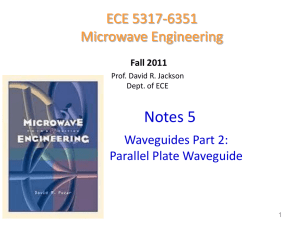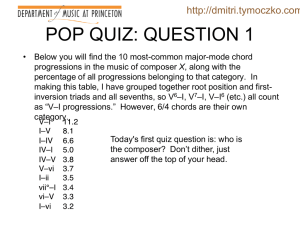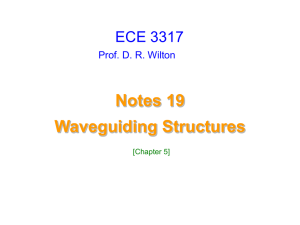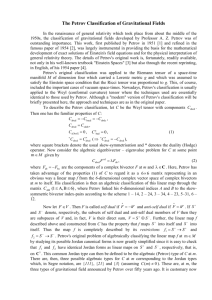Radiation forces on a dielectric sphere in the Rayleigh scattering
advertisement
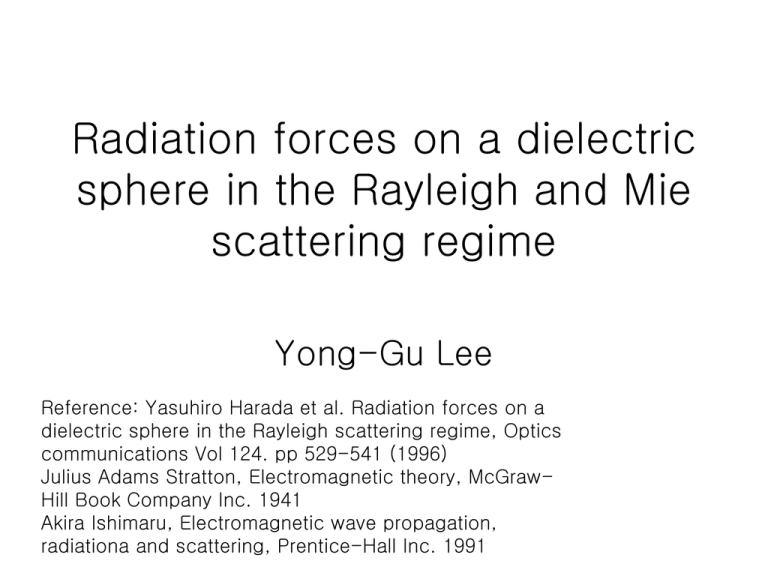
Radiation forces on a dielectric sphere in the Rayleigh and Mie scattering regime Yong-Gu Lee Reference: Yasuhiro Harada et al. Radiation forces on a dielectric sphere in the Rayleigh scattering regime, Optics communications Vol 124. pp 529-541 (1996) Julius Adams Stratton, Electromagnetic theory, McGrawHill Book Company Inc. 1941 Akira Ishimaru, Electromagnetic wave propagation, radiationa and scattering, Prentice-Hall Inc. 1991 Electromagnetic forces on charges and currents J nda s volt = watt ampere E ds c d dv dt V ampere coulomb 1 coulomb 2 3 meter meter ampere= meter 2 meter 3 second second meter 1 meter 2 second 2 second kilogram meter 2 1 coulomb second coulomb second weber kilogram meter 2 volt= weber volt second= second coulomb second kilogram× d B nda dt s coulombs volts kilogram Fe qE 3 2 2 2 meter meter second meter amperes webers kilogram [J B] dFm Ids B meter 2 meter 2 second 2 meter 2 [ E] Julius Adams Stratton, “Electromagnetic thoery,” pp 96-97, McGraw-Hill Book Company, 1941 Wave optics crash course • Wave equation • Helmholz eqn. • Elementary waves 2U c 1 2U 0 c 2 t 2 c0 n 2 k 2 U (r ) 0 U (r, t ) U (r )e j 2 t a(r)e j r e j 2 t 2 k c c – Spherical wave – Paraboloidal wave – Paraxial wave U (r ) A jkr e r x2 y 2 r z z x2 y 2 , r z 2z x y jk A A 2z U (r ) e jkr e jkz e r z 2 U (r) A(r)e jkz • Paraxial Helmholz eqn. T2 A j 2k A 0 z T2 2 2 x 2 y 2 2 2 A jkz 2 A jkz jkz A 2 jkz jkz A jkz A e e jke Ak e jke e k 2 Ae jkz 2 2 2 x y z z z 2 A jkz 2 A jkz A jkz jkz 2 A 2 e 2 e 2 jk e e x y z z 2 2 Gaussian beam • One simple solution to the paraxial Helmholtz equation provides the paraboloidal wave • Another solution of the paraxial Helmholtz equation provides the Gaussian beam. x2 y 2 A jkz jk 2 q ( z ) U (r ) e e q( z ) 1 1 j q( z ) R( z ) W 2 ( z) 2 wavefront radius of curvature and beam width 2 W0 W 2 z jkz jk 2 R z j z U (r ) A0 e e W z 1 z 2 2 W z W0 1 z0 z0 2 R z z 1 z z z tan 1 z0 1 z 2 W0 0 Electric-field vector within zeroth-order approximation in a paraxial Gaussian beam x E r E1 xˆ z jz0 x E1 xˆ z jz0 zˆ U r x2 y 2 A jkz jk 2 q ( z ) ˆz e e q( z ) A W0 x E1 xˆ zˆ e z jz jz W z 0 0 1 1 j q( z ) R( z ) W 2 ( z) z 2 W z W0 1 z0 z R z z 1 0 z z z tan 1 z0 2 1 z0 2 W0 jkW02 e jkz 2 jkW0 2 z E r xˆ E0 x2 y 2 W 2 z j e kW02 e jkz jk x2 y 2 j ( z ) 2R( z) H r zˆ 1 2 where Z 0 E r Z0 2 2 z 2 kz x 2 y 2 e 2 kW02 x 2 y 2 2 kW02 2 2 z 2 yˆ n2 0 cE r yˆ H r 2 is the intrinsic impedance of the medium for plane waves. The inherent relations of 2 0 n22 and 2 0 for non-conducting and non-magnetic medium are used in the previous formulation. H r zˆ E r, t Re E r exp ift , where Z 0 E r Z0 2 yˆ n2 0 cE r yˆ H r 2 is the intrinsic impedance of the medium for plane waves. The inherent relations of 2 H r, t Re H r exp ift , 0 n22 and 2 0 for non-conducting and non-magneti medium are used in the previous formulation. where f is the temporal angular frequency of the light. An instataneous energy flux crossing a unit area per unit time in the beam propagation direction corresponding to the Poynting vector is given by S r, t E r , t H r , t Re E r exp ift Re H r exp ift 1 1 E r exp ift E* r exp ift H r exp ift H * r exp ift 2 2 1 E r H* r E* r H r E r H r exp ift E* r H * r exp ift 4 1 1 E r H* r E* r H r E r H r exp ift E* r H* r exp ift 4 4 1 1 S r S* r E r H r exp ift E* r H * r exp ift 2 4 An important and measurable physical quantity in evaluating the radiation force of the light is the beam intensity or the irradiance at the position r ( x, y, z ). This is defined as a time-averaged version of the Poynting vector and is given by 1 I (r ) S r, t T Re E r H * r zˆ I (r ), 2 where 2P 1 I r e 2 2 w 1 z 0 2 x2 y 2 1 z 2 P w02n20cE02 / 4, and x, y, z x / w0 , y / w0 , z / w0 Eqn given in the paper is incorrect I (r ) S r, t T 1 Re E r H* r zˆ I (r ), 2 2 kz x 2 y 2 kW02 x 2 y 2 2 kz x 2 y 2 kW02 x 2 y 2 j j 2 2 2 2 2 2 2 2 2 2 2 2 2 2 jkW0 jkW0 1 kW0 2 z kW0 2 z kW0 2 z kW0 2 z jkz jkz zˆ Re E0 e e e E e e e / z 0 0 2 2 2 jkW0 2 z jkW0 2 z kW02 x 2 y 2 kW02 x 2 y 2 2 2 2 2 jkW02 jkW02 kW02 2 z kW02 2 z 1 zˆ Re E0 e E e / z 0 0 2 2 2 jkW 2 z 0 jkW0 2 z zˆ 2 0 kW 1E z0 2 kW02 2 0 2 2z 2 2 2 e kW02 x 2 y 2 2 kW02 2 z 2 H r zˆ where Z 0 E r Z0 2 2 yˆ n2 0cE r yˆ H r = 0 0 0 = is the intrinsic impedance of the medium for plane wav 0 n22 0 0 n22 The inherent relations of 2 0 n22 and 2 0 for non-conducting and non-magnetic medium are used in the previous formulation. 2P 1 I r e 2 2 w0 1 z 2 x2 y 2 1 z 2 n cE 2 1 2 0 0 e 2 2 1 z 2 x2 y 2 1 z 2 P w02n20cE02 / 4, and x, y, z x / w0 , y / w0 , z / w0 2 x2 y 2 2 P 1 1 z 2 I r e (Saleh eq. 3.1-15) 2 2 w 1 z 0 P w02 n2 0 cE02 / 4, and x, y, z x / w0 , y / w0 , z / w0 22 2 2 2 P w02 2 P w02 w0 z 0 0 I r d d 0 0 w02 w02 z 2 e d d w02 w02 z 2 2 2 2 1 2 2 w02 z 2 2 P w02 w02 z 2 2 P 2 2 2 w w z 4 0 0 H r zˆ where Z 0 E r Z0 2 yˆ n2 0 cE r yˆ H r 2 is the intrinsic impedance of the medium for plane waves. The inherent relations of 2 0 n22 and 2 0 for non-conducting and non-magnetic medium are used in the previous formulation. It must be noted that previous expressions can not describe a rigorous behavior of the Gaussian laser beam, especially a tightly focused beam. The important parameter in this context is a nondimensional one give by 1 s= . kw 0 2 w 0 Previous descriptions are based on paraxial approximations to the scalar wave equation of the Gaussian beam and correspond to a zeroth-order approach in s. Thus, as far as s 1, these descripts are quite accurate. However for other values the percentage of erros are 0.817% for s=0.02, and 4.37% for s = 0.1. What is the fundamental difference between the Rayleigh, Mie, and Optical regimes? With Rayleigh scattering, the electric field is assumed to be invariant in the vicinity of the particle Taken from the course notes of Radar Metrology by Prof. Bob Rauber (UIUC) http://www.atmos.uiuc.edu/courses/atmos410-fa04/presentations.html The angular patterns of the scattered intensity from particles of three sizes: (a) small particles, (b) large particles, and (c) larger particles Rayleigh scattering pattern Taken from the course notes of Radar Metrology by Prof. Bob Rauber (UIUC) http://www.atmos.uiuc.edu/courses/atmos410-fa04/presentations.html Einc incident plane wave p Dielectric Sphere (water drop) A plane wave with electric field Einc induces an electric dipole p in a small sphere. The induced dipole is parallel to the direction of Einc which is also the direction of polarization of the incident wave. Taken from the course notes of Radar Metrology by Prof. Bob Rauber (UIUC) http://www.atmos.uiuc.edu/courses/atmos410-fa04/presentations.html Slides taken from the lecture notes of Optical Tweezers in Biology by Prof. Dmitri Petrov https://www.icfo.es/courses/biophotonics2006/html/ Slides taken from the lecture notes of Optical Tweezers in Biology by Prof. Dmitri Petrov https://www.icfo.es/courses/biophotonics2006/html/ Metal spheres Slides taken from the lecture notes of Optical Tweezers in Biology by Prof. Dmitri Petrov https://www.icfo.es/courses/biophotonics2006/html/ Slides taken from the lecture notes of Optical Tweezers in Biology by Prof. Dmitri Petrov https://www.icfo.es/courses/biophotonics2006/html/ Slides taken from the lecture notes of Optical Tweezers in Biology by Prof. Dmitri Petrov https://www.icfo.es/courses/biophotonics2006/html/ Slides taken from the lecture notes of Optical Tweezers in Biology by Prof. Dmitri Petrov https://www.icfo.es/courses/biophotonics2006/html/ Slides taken from the lecture notes of Optical Tweezers in Biology by Prof. Dmitri Petrov https://www.icfo.es/courses/biophotonics2006/html/ Slides taken from the lecture notes of Optical Tweezers in Biology by Prof. Dmitri Petrov https://www.icfo.es/courses/biophotonics2006/html/ Slides taken from the lecture notes of Optical Tweezers in Biology by Prof. Dmitri Petrov https://www.icfo.es/courses/biophotonics2006/html/ Slides taken from the lecture notes of Optical Tweezers in Biology by Prof. Dmitri Petrov https://www.icfo.es/courses/biophotonics2006/html/


